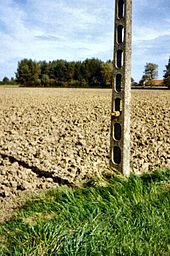This summer, my husband and I had the extreme pleasure of touring World War I battlefields in Belgium and Northern France. We have always gone on trips like this on our own. We’ve done the research, made the reservations, and done all the planning by ourselves. For this trip, I felt I overwhelmed by the number of places I wanted to go. I was afraid I’d miss something crucial. So we booked a tour with a company called Beyond Band of Brothers. It turned out to be an excellent decision.

One of the things that BBoB does that really enhances the experience is hire local tour guides. In Flanders, a region that now encompasses part of Belgium and France, that was Iain McHenry, a published author and historian whose understanding of battle tactics and cemeteries was encyclopedic. Iain began studying the Great War when he was in the military and assigned to Belgium. He has since gone on to do research for families of soldiers, for BBC programs, and for his book on the 177th Tunneling Company.
 A telegraph pole on the side of a field in Belgium. Note the shells that a farmer has placed in it for disposal.
A telegraph pole on the side of a field in Belgium. Note the shells that a farmer has placed in it for disposal.While we were driving from one site to another, Iain explained that a lot of unexploded ordnance still litters the fields of Flanders. Much of it is still dangerous. France's Department of Mine Clearance, for instance, recovers 900 tons of UXO every year.
Farmers in the region have taken to calling this the Iron Harvest. Every year, especially during the spring planting and fall ploughing, they uncover unexploded ordnance, rolls of barbed wire, shrapnel, bullets, and other things in their fields. Iain explained that a lot of farmers carry what they find to the sides of their fields and deposit them where bomb squads can recover them.
Farmers in the region have taken to calling this the Iron Harvest. Every year, especially during the spring planting and fall ploughing, they uncover unexploded ordnance, rolls of barbed wire, shrapnel, bullets, and other things in their fields. Iain explained that a lot of farmers carry what they find to the sides of their fields and deposit them where bomb squads can recover them.
Iain took us to one farm, whose inhabitants have not only endured the dangers of living and farming such dangerous soil, but embraced its history. As we pulled into the farmyard of Pond Farm, a pleasant, middle-aged blond woman welcomed us.

She explained in halting English that the farm had been completely destroyed during World War I. When her great-grandfather returned after the war, he built a small shed for the family to live in. Next came a barn, and then the house in which the family lives today. Eventually, shed became a museum of things they picked up in the fields.
The collection was intriguing. One thing I noticed were dozens of tiny horseshoes. Noting the confusion on my face, she explained that they were not actually for ponies; they were the heel guards from the hobnailed boots that both German and English soldiers wore.
Her son, Stijn, became intrigued by all the ephemera of war. He's been collecting things from the fields since he was a child.
The collection was intriguing. One thing I noticed were dozens of tiny horseshoes. Noting the confusion on my face, she explained that they were not actually for ponies; they were the heel guards from the hobnailed boots that both German and English soldiers wore.
Her son, Stijn, became intrigued by all the ephemera of war. He's been collecting things from the fields since he was a child.
When he found the remnants of a tank in his field, he decided to build one of his own. He requested plans for a Mark IV from the British government and has been working on building one ever since. His mother was pleased to show us his handiwork, parked in the barn among the farm equipment. Building a tank is no small or inexpensive feat. If you would like to help, donations would be gratefully accepted here.
World War I has been over now for a hundred years, but the land and its people are still recovering. The Iron Harvest is a legacy that will continue to challenge the people for centuries to come.










No comments:
Post a Comment